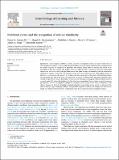Perirhinal cortex and the recognition of relative familiarity
Abstract
Spontaneous object recognition (SOR) is a widely used task of recognition memory in rodents which relies on their propensity to explore novel (or relatively novel) objects. Network models typically define perirhinal cortex as a region required for recognition of previously seen objects largely based on findings that lesions or inactivations of this area produce SOR deficits. However, relatively little is understood about the relationship between the activity of cells in the perirhinal cortex that signal novelty and familiarity and the behavioural responses of animals in the SOR task. Previous studies have used objects that are either highly familiar or absolutely novel, but everyday memory is for objects that sit on a spectrum of familiarity which includes objects that have been seen only a few times, or objects that are similar to objects which have been previously experienced. We present two studies that explore cellular activity (through c-fos imaging) within perirhinal cortex of rats performing SOR where the familiarity of objects has been manipulated. Despite robust recognition memory performance, we show no significant changes in perirhinal activity related to the level of familiarity of the objects. Reasons for this lack of familiarity-related modulation in perirhinal cortex activity are discussed. The current findings support emerging evidence that perirhinal responses to novelty are complex and that task demands are critical to the involvement of perirhinal cortex in the control of object recognition memory.
Citation
Ameen-Ali , K E , Sivakumaran , M , Eacott , M J , O'Connor , A R , Ainge , J A & Easton , A 2021 , ' Perirhinal cortex and the recognition of relative familiarity ' , Neurobiology of Learning and Memory , vol. 182 , 107439 . https://doi.org/10.1016/j.nlm.2021.107439
Publication
Neurobiology of Learning and Memory
Status
Peer reviewed
ISSN
1074-7427Type
Journal article
Description
This work was supported and funded by a National Centre for the Replacement, Refinement and Reduction of Animals in Research (NC3Rs) studentship to K.E.A.-A. (NC/K500252/1) and an Eastbio (BBSRC) studentship to M.G.H.Collections
Items in the St Andrews Research Repository are protected by copyright, with all rights reserved, unless otherwise indicated.

